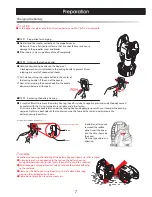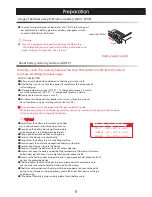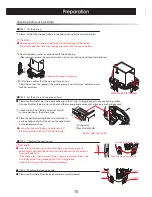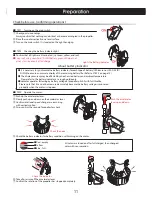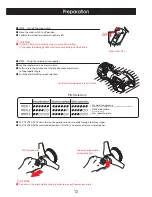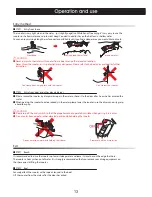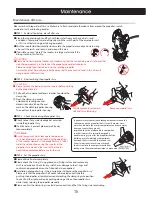
Turn to Pitch 4 or 5
Hold the scooter with your hand
Grip the scooter between your knees
Adjust buoyancy
Adjust buoyancy
Rise with scooter's weight
Bring the body into an upright position
Turn to minimum speed
①
Reduce speed by shifting the accelerator lever to the low-speed position.
②
Once the speed is reduced and the weight of the scooter can be felt, adjust buoyancy.
③
Using the same hand that moved the accelerator lever, take hold of the grip on the saddle unit. Hold the
scooter with your hand and also grip it between your knees.
④
After the scooter stops, maintain left and right balance and go into hovering mode.
Do this by adjusting buoyancy once again while allowing the weight of the scooter to bring the body into an
upright position.
Repeating steps 1 and 2 will reduce the amount of buoyancy shift that occurs at the point in which the scooter
reaches a complete stop, making for easier maneuvering.
■
Moving to hovering mode.
SPEED 4
~
5
26
⑤
From there, lean forward, and kick off the seabed in order to avoid disturbing the sand.
Up to a riding position
Lean forward
Kick off the seabed
Grip with the knees to hold the scooter
Upright position
Approach the scooter
●
Learning to be pushed by the scooter.
The key to successful takeoff is to learn to be pushed by the scooter. If the diver is too eager to move forward,
the diver and the scooter will not be able to move as one, which will throw the diver off balance and prevent
a smooth takeoff.
●
Counter balancing the rotation torque.
Right after takeoff, the diver will feel the scooter rotate in a counterclockwise motion relative its forward movement.
This is due to the rotation torque of the propeller. As a way of countering this movement, the diver can twist one's
upper body to the right. Another simple technique is for the diver to imagine taking off in the direction of "11:00
(forward to the left)". This will naturally twist the diver's body to the right, which will reduce the effect of the rotation
torque. Once a stable forward motion is achieved, the rotation torque will become weaker.
●
Preventing sand disturbance.
The water current caused by the propeller is more far-reaching than one might imagine. At take off, the diver
must be aware of what is behind the diver, so as not to hit other divers with a slipstream coming from the propeller.
Taking off from a landing position will disturb the sand underneath. Kick to move slightly off the seabed and
sufficiently tilt forward before turning on the propeller.
①
Hold the scooter in an upright position on the seabed.
②
Approach the scooter from behind, and position the body above the saddle of the accelerator unit.
③
Pull the scooter up to a riding position by taking hold of the handle of the saddle unit.
④
Firmly grip with the knees to hold the scooter.
Taking off from a landing position will disturb the
sand underneath.
Kick to move slightly off the seabed and sufficiently
tilt forward before turning on the propeller.
⑥
After moving away from the seabed with the entire body tilted forward to around a 45-degree angle, pull the
accelerator lever for takeoff.
3. Take off
■
Taking off from a landing position.
SPEED 4
~
6
27
21

